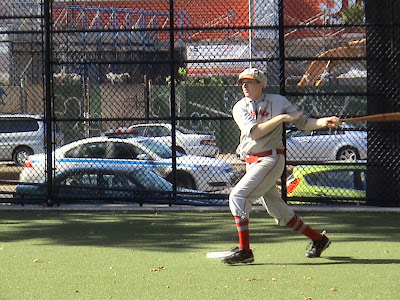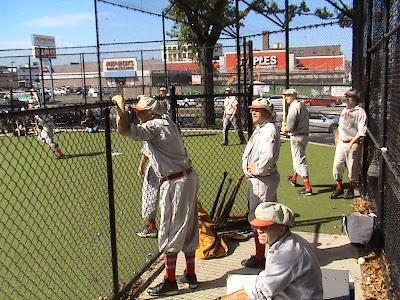Old Stone House - Photo by Mark Granieri
In the first game, the Gothams got off to an early an early 6-1 lead which basically became insurmountable when the Neshanock failed to score over the next five innings. Some late offense made the final score 14-5 in a match that wasn't that close. While runs were hard to come by both Tom "Thumbs" Hoepfner and Scott "Snuffy" Hengst recorded three hit games. By far the most impressive performance in the opener came on defense when Danny "Batman" Shaw flawlessly handled seven chances in left field.
Danny "Batman" Shaw
The second game started out like the first with the Gothams scoring three tallies in their first at bat, but this time the Neshanock didn't score an early run. In fact, not only didn't Flemington score an early run, the club didn't score any runs in an 8-0 shutout lost, reportedly only the second shut out in the club's history. All told the Neshanock managed only three hits, two by "Jersey" Jim Nunn who missed a clear score when he was retired in his final at bat. The two losses left Flemington at 22-21 for the season with scheduled doubleheaders left at Elkton, Maryland on October 20th and at Waterloo Village (against the Hoboken "Nine"), the following Saturday, October 26th.
1912 Opening Day at Washington Park, the Dodgers last pre-Ebbets Field home opener
Today's venue was both interesting and challenging as a site for a vintage game. The matches were played on a small, emphasis on the small, park (appropriately named Washington Park) located adjacent to the Old Stone House. There's no lack of base ball history in the area as the four incarnations of the Washington Park base ball grounds (home to the Dodgers - pre Ebbets Field and the Brooklyn Federal League Tip Tops) were in located in the area, part of it on the field where we played today. The problem is that the park is small with a rectangular shape effectively making it impossible to have a right field. That was difficult enough, but it became more harder because of the number of people who wanted to use or sit on the field for some other purpose and were unwilling to leave. I suppose there's a level of historical accuracy in that because crowd control probably became an issue at 19th century games, but there are some aspects of the old game that don't need to be re-created.
Searching for offense - photo by Mark Granieri
The Neshanock's visit to Brooklyn would most likely have made me think about the 19th century inter action between New Jersey clubs and those from the City of Churches, but the seed had already been planted from another direction. Work is underway on a November 2014 symposium on 19th century base ball in the Greater New York area and I was pleased to be asked to serve on the planning committee. As part of starting to think about that I sought some parameters for what areas in New Jersey were to be considered part of Greater New York. In his response, Peter Mancuso, chair of SABR's 19th century committee reminded me of a Brooklyn - New Jersey connection I should have remembered on my own especially since I wrote the book or at least that part of the book.
Photo by Mark Granieri
I'm referring to my essay in Baseball Founders about the Nassau Club of Princeton, effectively Princeton University's first base ball team. As I've written before in this blog, the Nassau Club was started in large part by Lewis Mudge and two other young men from Brooklyn who brought their bats and balls as well as their love of the game with them when they enrolled at the College of New Jersey in the fall of 1858. But Brooklyn and New Jersey's base ball connections go back even further than that. In fact, the first New Jersey club matches with out of state clubs were three games between the Pioneer Club of Jersey City and the Columbia Club of Brooklyn. Not playing any favorites between New Jersey's two largest cities, the Brooklyn club also played two 1855 matches with the Olympic Club of Newark. As also noted previously the Pioneer - Columbia matches also marked the first time a New Jersey club traveled out of state.
Current research indicates that by 1860 there were base ball clubs in Essex, Hudson, Morris, Mercer, Somerset, Union and Middlesex Counties
These inaugural season (for New Jersey base ball) matches were also no one time thing as Brooklyn and New Jersey clubs played at least once in every season through 1860. What's especially interesting is the broad range of locations encompassed by this competition. Research to date indicates that antebellum base ball clubs existed in seven of New Jersey's twenty-one counties. Matches between Brooklyn and New Jersey clubs took place in six of the seven counties with Morris appearing to be the only exception. Of special note is an 1858 visit of Brooklyn's Pastime Club to Trenton, New Jersey's state capital. Although Trenton had a base ball club as early as 1856, the only match game with a club outside of Trenton, was the 1858 contest between the Pastimes and a picked nine of the Trenton and Mercer Clubs. The Brooklyn team apparently made the round trip from the East River to the Delaware in one day even forgoing a "collation" at Dr. Joline's American Hotel and settling for lesser fare at Whitecar's in order to catch their return train.
Daily True American - September 23, 1858
Until 1860 New Jersey clubs played more matches each year against Brooklyn clubs than with New York foes, even though the leading New York clubs actually played their matches in New Jersey. Part of this has to be attributable to the fact that New York teams like the Knickerbockers, Eagles and Gothams didn't play a lot of match games during the pre-war years. Given the social nature of the Manhattan clubs, it's also probably fair to say they preferred to play against fellow New Yorkers they knew on a regular basis and had competed against since the beginning of the decade. At the same time they also accepted the ability of New Jersey players as evidenced by the half-dozen or so Jersey City players who joined the Eagle Club for the 1856 season.
In 1860, however, the situation was reversed as the New Jersey - New York matches significantly out numbered the Brooklyn - New Jersey encounters. While some of the old time clubs participated, more are less well known names. I don't know much about the development of less "prominent" clubs in New York City, but possibly growth in the number of clubs as well as the desire to play additional matches led to more competition between city and state. By this point, however, base ball or more specifically the New York game had taken firm root in the Garden State. Thanks for that to some degree belongs to Brooklyn's base ball clubs who were not only willing to compete with their New Jersey counterparts, but also made road trips to do so.







No comments:
Post a Comment